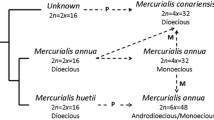Abstract
In EuropeAthyrium filix-femina has a constant chromosome number (2n = 80) and is sexual. The normal type of reproduction is intergametophytic crossing. In the gametophyte phase there is a hormone system which induces dark germination of spores and antheridium formation. Sporophytes originating from single prothalli show that a genetic load is present in all population examined. It appears not to be a simple allelic load but a complicated balanced system. Morphological variability can be interpreted as the expression of the genetic heterogeneity of populations. There are no crossing barriers, not even between insular populations hundreds of kilometers apart.
Similar content being viewed by others
References
Andersson-Kottö, Irma, 1931: The genetics of ferns. — Bibliogr. Genet.8, 269–293.
Atkinson, Lenette R., 1973: The gametophyte and family relationships. InJermy, A. C. & al. (Eds.): The Phylogeny and Classification of the Ferns, 73–90. — Bot. J. Linn. Soc.67, Suppl.1. — London: Academic Press.
Czaja, A. T., 1921: Über Befruchtung, Bastardierung und Geschlechtertrennung bei Prothallien homosporer Farne. — Z. Bot.13, 545–589.
Dobzhansky, T., 1964: How do the genetic loads affect fitness of their carriers inDrosophila populations? — Amer. Naturalist87, 151–166.
—, 1963: Genetics of natural populations 34. Adaptive norm, genetic load and genetic elite inDrosophila pseudoobscura. — Genetics48, 1467–1485.
Döpp, W., 1939: Cytologische und genetische Untersuchungen in der GattungDryopteris. — Planta29, 481–533.
—, 1950: Eine die Antheridienbildung bei Farnen fördernde Substanz in den Prothallien vonPteridium aquilinum (L.)Kuhn. — Ber. Deutsch. Bot. Ges.63, 139–147.
—, 1962: Weitere Untersuchungen über die Physiologie der Antheridienbildung beiPteridium aquilinum. — Planta58, 483–508.
Fah Seong, Liew, 1972: Numerical taxonomic studies on North American lady ferns and their allies. — Taiwania17, 190–221.
Harper, J. L. 1977: Population Biology of Plants. — London, New York, San Francisco: Academic Press.
Klekowski, E. J., 1969: Reproductive biology of thePteridophyta II. Theoretical considerations. — Bot. J. Linn. Soc.62, 347–359.
—, 1970: Populational and genetic studies of a homosporous fern —Osmunda regalis. — Amer. J. Bot.57, 1122–1138.
Klekowski, E. J., 1971: Ferns and genetics. — BioScience21, 317–322.
—, 1972: Genetical features of ferns as contrasted to seed plants. — Ann. Missouri Bot. Gard.59, 138–151.
—, 1973a: Genetic load inOsmunda regalis populations. — Amer. J. Bot.60, 146–154.
—, 1973b: Sexual and subsexual systems in homosporous pteridophytes: A new hypothesis. — Amer. J. Bot.60, 535–544.
—, 1966: Evolutionary significance of polyploidy in thePteridophyta. — Science (Wash.)153, 305–307.
—, 1974: Nonhomologous chromosome pairing in the fernCeratopteris. — Amer. J. Bot.64, 422–432.
—, 1968: Reproductive biology of thePteridophyta I. General considerations and a study ofOnoclea sensibilis. — J. Linn. Soc. Bot.60, 315–324.
Lagerberg, T., 1908: Morphologisch-biologische Bemerkungen über die Gametophyten einiger schwedischer Farne. — Svensk Bot. Tidskr.2, 229–275.
Lloyd, R. M., 1974a: Reproductive biology and evolution in thePteridophyta. — Ann. Missouri Bot. Gard.61, 318–331.
—, 1974b: Mating systems and genetic load in pioneer and nonpioneer HawaiianPteridophyta. — Bot. J. Linn. Soc.69, 23–35.
Löve, A., Löve, Doris, Pichi Sermolli, R. E. G., 1977: Cytotaxonomical atlas of thePteridophyta. — Vaduz: J. Cramer.
Lovis, J. D., 1977: Evolutionary pattern and processes in ferns. — Adv. Bot. Research4, 229–415.
Luerssen, C., 1889: Die Farnpflanzen. In Rabenhorsts Kryptogamen-Flora von Deutschland, Österreich und der Schweiz, Bd.3. — Leipzig: E. Kummer.
Manton, Irene, 1950: Problems of Cytology and Evolution in thePteridophyta. — Cambridge: University Press.
Moore, T., 1859: The Nature Printed British Ferns. Vol.2. — London: Bradbury & Evans.
Näf, U., 1956: The demonstration of a factor concerned with the initiation of antheridia in polypodiaceous ferns. — Growth20, 91–105.
—, 1968: On separation and identity of fern antheridiogens. — Plant Cell Physiol.9, 27–33.
—, 1975: On sexual reproduction in the fern speciesPteridium aquilinum. InMohan Ram, H. Y. & al. (Eds.): Form, Structure and Function in plants. — Nauchand, Meerut: Sarita Prakashan.
Pettersson, B., 1940: Experimentelle Untersuchungen über die euanemochore Verbreitung der Sporenpflanzen. — Acta Bot. Fenn.25, 1–103.
Raynor, G. S., Ogden, E. C., Hayes, Janet V., 1976: Dispersion of fern spores into and within a forest. — Rhodora78, 473–487.
Schneller, J. J., 1975: Untersuchungen an einheimischen Farnen, insbesondere derDryopteris filix-mas Gruppe. 3. Teil. Oekologische Untersuchungen. — Ber. Schweiz. bot. Ges.85, 110–159.
Schraudolf, H., 1962: Die Wirkung von Phytohormonen auf die Keimung und Entwicklung von Farnprothallien. — Biol. Zentralbl.81, 731–740.
Stokey, Alma G., 1951: The contribution by the gametophyte to the classification of the homosporous ferns. — Phytomorphology1, 39–57.
Tryon, R. M., Vitale, G., 1977: Evidence for antheridiogen production and its mediation of a mating system in natural populations of fern gametophytes. — Bot. J. Linn. Soc.74, 243–249.
van den Ende, H., 1976: Sexual Interactions in Plants. Sex Hormones in Ferns, p. 130–142. — London: Academic Press.
Voeller, B. R., 1964: Gibberellins: Their effect on antheridium formation in fern gametophytes. — Science (Wash.)143, 373–375.
—, 1971: Development physiology of fern gametophytes: Relevance for biology. — BioScience21, 266–270.
Waddington, C. H., 1959: Canalization of development and genetic assimilation of acquired characters. — Nature183, 1654–1655.
Wilkie, D., 1956: Incompability in bracken. — Heredity10, 247–256.
Author information
Authors and Affiliations
Rights and permissions
About this article
Cite this article
Schneller, J.J. Biosystematic investigations on the lady fern(Athyrium filix-femina) . Pl Syst Evol 132, 255–277 (1979). https://doi.org/10.1007/BF00982389
Received:
Issue Date:
DOI: https://doi.org/10.1007/BF00982389




